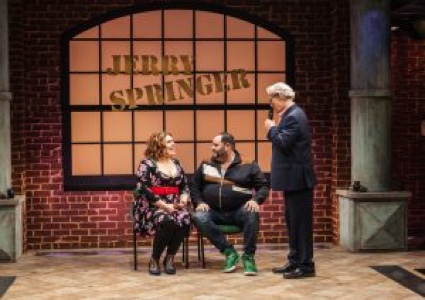Jerry Springer: A Good Fight and a Bumpy Opera

JERRY! JERRY! JERRY!
At some point in everybody’s life, they have watched the Jerry Springer Show, the syndicated television talk show/fight fest in which folks with problems bring them to Jerry and his wide- eyed audience and try to straighten them out as the crowd chants JERRY, JERRY, JERRY. Jerry Springer, the amiable, laid back host, cue cards always in his hands, tries to put these human Humpty Dumpties back together again.
The guests are different but the problems are all pretty much the same – bad male/female relationships of some kind. It is usually the stray male who is sleeping with his wife’s sister or best friend. The couple argue and then Jerry introduces the third wheel and when he/she comes on stage everybody jumps up and starts to fight. The audience roars and the ratings soar. Roughly two million people watch the show each week. It is ghastly, wonderful nonsense and nobody ever confuses it with a Renaissance Literature seminar at Yale.
Now Jerry Springer and his motley crew have leaped on to the stage in Jerry Springer – the Opera, that opened Thursday at the Pershing Square Signature Center on W. 42d Street, New York.
It is a good look at television history, but it’s not exactly Madame Butterfly.
It is an opera. Just about all of the dialogue in the show, with book and lyrics by Richard Thomas and Stewart Lee, is sung. The music is very opera-ish with long, slow melodies and hard to understand lyrics. There is a Greek chorus that sings much of it, just as it did back in the days of Aristophanes. There is a story, sort of. There are heroes (Jerry), assistant heroes (the screeching, jilted girlfriend, a guy who thinks he’s a 33-year-old baby and runs around in a diaper and an oafish guy bounding about in a Chicago Bulls tee shirt) and villains (angry stage manager and the devil).
The first act is a recreation of a Springer television show. A man is going with one woman but has another on the side. Everybody fights and screams, held apart by the traditional stage hand, and Jerry navigates across the stage, cue cards in hand, asking inane questions. He is shot at the end of act one. In act two, Jerry is in hell and the Devil forces him to do a show with the Devil and God because the Devil maintains, with a lot of really good singing and dancing, that he is a victim. He got a raw deal way back when and God got the big house and all the fancy cars.
JERRY! JERRY! JERRY!
That’s the opera. It is, well, bumpy.
The shame is that Springer has a fascinating biography and an opera or play about him would be an enthralling tale and a nice chapter in both political and entertainment history. That’s why I went to see it.
Lots of people were born in World War II, but Jerry Springer was really born in it; he came into the world in a London subway station during the Luftwaffe bombing of the city. His parents were German Jews who fled to England. Both his grandmothers died in German concentration camps His uncle, a doctor, died there, too.
Jerry and his parents moved to New York City and in 1956 Jerry became, at 12, a fan of John F, Kennedy and later joined the Democratic Party. In 1970 he ran for Congress and nearly won (he got 45% of the vote in a Republican district). He was an army reservist who was called to active duty. Springer carved out a career as a successful lawyer in Ohio. He was elected to the Cincinnati city council in 1971, resigned after a sex scandal and was re-elected, after admitting to everything, in a landslide in 1975. Shortly afterwards, the council elected him Mayor for one year (the prescribed term in that era). He ran for Governor in 1982, but lost and on two other occasions considered running for the U.S. Senate but did not.
Jerry became a local TV newscaster and analyst and then started the Jerry Springer Show in 1991. The rest is history.
Terence Mann, as Jerry, does try to tell his historical story. He explains that he was once the Mayor of Cincinnati and an adviser to Bobby Kennedy, but he stops after just one or two lines. That’s the tragedy - that this weary opera could have been a good one.
The biggest problem with the opera is the really profane language, and I mean obscene. The material that is bleeped off the TV show is nothing compared to the language, and sex innuendoes, in the opera. I am no prude, but the language made me just cringe. There is a lot of foul language and sexual descriptions in some plays, but this really dreadful.
The opera’s director, John Rando, did a fine job with a tenuous script and muddled story. Choreographer Chris Bailey’s work with his dancers in the small space is to be applauded. The acting is quite good. Bailey gets fine performances from Mann as Jerry, Luke Grooms as Dwight, Florrie Bagel as Peaches, Beth Kirkpatrick as Zandra, Justin Keye as Montel, Jill Paice as Baby Jane, Jennifer Allen as Irene, Nathaniel Hackmann as Chucky and, especially, the mercurial Will Swenson, who plays both the stage manager and the Devil with great pizzazz. The other actors and singers in the ensemble are all quite good.
So, we have an opera about Jerry Springer. What’s next, a ballet about Judge Judy?
PRODUCTION: The opera is produced by The New Group. Sets: Derek McLane, Costumes: Sarah Laux, Lighting: Jeff Croiter, Sound: Joshua D. Reid, Projection Design: Olivia Sebesky. The opera is directed by John Rando. It runs through March 11.